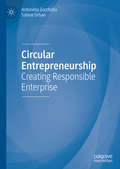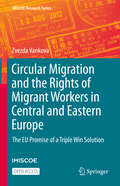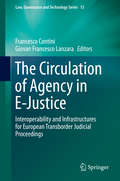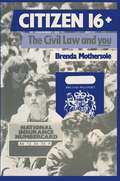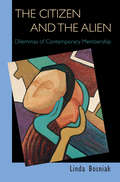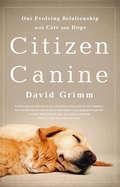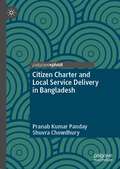- Table View
- List View
Circular Economy in Emergency Housing: A Research Strategy of Climate Change (SpringerBriefs in Climate Studies)
by Pilar Mercader-Moyano Paula Porras-PereiraIn recent years, there has been an upsurge in the number of forced displacements due to natural disasters, armed conflicts, and pandemics, which has favoured an increase in the number of temporary accommodations. Although the provision of shelter after an emergency situation is one of the priorities of humanitarian aid, the reality is that the conditions in which people live in a situation of forced displacement are absolutely precarious and overcrowded. Nowadays, this type of housing tends to have a short lifespan, deepening the environmental impact and the generation of waste. Likewise, added to this great problem is the linear economic system implemented worldwide, which also causes a high rate of waste.This investigation develops an eco-efficient design protocol that determines the basic premises in any emergency situation, therefore avoiding the precarious nature to which those in forced displacement are exposed. Moreover, the research investigates different constructive solutions that can respond to situations of natural catastrophes or humanitarian disasters where emergency housing is needed as well as the possible alternatives from the point of view of circular economy. Eco-efficient and environmentally correct solutions are sought, which can be adaptable to the different scenarios where emergency housing may be needed, thus creating a rapid, easy, functional, and environmentally correct architecture, adaptable to these types of situations. The study shows that the factors that characterize emergency architecture can be an example of where the issues around the sustainability factor are applied in a practical way. The main objectives of this study are to develop an eco-efficient design protocol which determines the basic premises in any emergency situation and to find eco-efficient and environmentally correct solutions, adaptable to different scenarios, which have similar climatic characteristics, and where emergency housing may be needed, thus creating a type of ephemeral architecture but sensitive to the user to whom it is intended and in accordance with the optimal conditions of habitability.
Circular Economy in the European Union: Organisational Practice and Future Directions in Germany, Poland and Spain (Routledge Research in Sustainability and Business)
by Dagmara Lewicka Joanna Zarębska Roman Batko Beata Tarczydło Maciej Wożniak Dariusz Cichoń Monika PecCircular Economy in the European Union: Organisational Practice and Future Directions in Germany, Poland and Spain presents the EU's journey towards a Circular Economy (CE), identifying significant organizational practices in this gradually adopted field among member countries. The book also aims to develop and propose innovative initiatives and practices for implementing CE across various economic sectors in selected EU countries, such as Poland, Spain and Germany. Covering topics which include the implementation of CE in the EU and worldwide, green employee behaviors, corporate social responsibility in creating pro-environmental attitudes and models of eco-digital factory transformation in SMEs, the book emphasizes the importance of innovative, environmentally friendly, low-waste, and low-emission technologies. Consisting of thirteen interconnected chapters, it discusses the challenges and opportunities of CE, the importance of business engagement in addressing social and environmental problems, and provides practical examples of innovative solutions in various sectors. This volume will be of great interest to students and scholars of circular economy, corporate governance, business ethics and sustainable business, as well as entrepreneurs, managers, government representatives, and non-governmental organizations active in CE.
Circular Economy in the European Union: Organisational Practice and Future Directions in Germany, Poland and Spain (Routledge Research in Sustainability and Business)
by Dagmara Lewicka Joanna Zarębska Roman Batko Beata Tarczydło Maciej Wożniak Dariusz Cichoń Monika PecCircular Economy in the European Union: Organisational Practice and Future Directions in Germany, Poland and Spain presents the EU's journey towards a Circular Economy (CE), identifying significant organizational practices in this gradually adopted field among member countries. The book also aims to develop and propose innovative initiatives and practices for implementing CE across various economic sectors in selected EU countries, such as Poland, Spain and Germany. Covering topics which include the implementation of CE in the EU and worldwide, green employee behaviors, corporate social responsibility in creating pro-environmental attitudes and models of eco-digital factory transformation in SMEs, the book emphasizes the importance of innovative, environmentally friendly, low-waste, and low-emission technologies. Consisting of thirteen interconnected chapters, it discusses the challenges and opportunities of CE, the importance of business engagement in addressing social and environmental problems, and provides practical examples of innovative solutions in various sectors. This volume will be of great interest to students and scholars of circular economy, corporate governance, business ethics and sustainable business, as well as entrepreneurs, managers, government representatives, and non-governmental organizations active in CE.
Circular Entrepreneurship: Creating Responsible Enterprise
by Antonella Zucchella Sabine UrbanThis original book explores how the principles of circularity, considered a law of nature but neglected within the materialistic orientation of the industrial age, are becoming attractive again in business and society. Investigation reveals enterprises small and large delivering a stimulating message, from changes in entrepreneurial mindsets to the inclusive use of new technologies and a push for innovation. Zucchella and Urban explore the novel concept of circular enterprise, showing how, with their capacity to innovate, these firms are becoming the most powerful actors of a new, sustainable social order. They examine two fundamental questions: why is this revolution occurring now, and how is it being implemented? Focusing on the most innovative practices, they demonstrate the potential of circular enterprise for industry and wider society, making clear that a new world is emerging.
Circular Migration and the Rights of Migrant Workers in Central and Eastern Europe: The EU Promise of a Triple Win Solution (IMISCOE Research Series)
by Zvezda VankovaThis open access book adopts a rights-based approach to shed light on the different legal and policy instruments that have been developed to implement circular migration policies in the EU, and their consequences for the rights of migrant workers. It contributes to the understanding of the meaning of this concept in general and in the EU, as well as specifically regarding its Eastern neighborhood. The book provides a comprehensive picture of the formation and implementation of the EU’s circular migration approach that has developed through both EU and national instruments, on the basis of comparative case study analysis of Bulgaria and Poland’s migration laws and policies. By applying empirical legal research methods, it draws conclusions about the policy outcomes from the implementation of the various migration instruments falling under the circular migration umbrella and shows the consequences for the rights of migrant workers as a result of the application of different policy options. Along with its value to an academic audience, the book can be used by policy makers at the EU, international and national levels, as well as by international organisations and NGOs working in the field of migration law and policy.
Circulation and Control: Artistic Culture and Intellectual Property in the Nineteenth Century
by Marie-Stéphanie Delamaire And Will SlauterThe nineteenth century witnessed a series of revolutions in the production and circulation of images. From lithographs and engraved reproductions of paintings to daguerreotypes, stereoscopic views, and mass-produced sculptures, works of visual art became available in a wider range of media than ever before. But the circulation and reproduction of artworks also raised new questions about the legal rights of painters, sculptors, engravers, photographers, architects, collectors, publishers, and subjects of representation (such as sitters in paintings or photographs). Copyright and patent laws tussled with informal cultural norms and business strategies as individuals and groups attempted to exert some degree of control over these visual creations. With contributions by art historians, legal scholars, historians of publishing, and specialists of painting, photography, sculpture, and graphic arts, this rich collection of essays explores the relationship between intellectual property laws and the cultural, economic, and technological factors that transformed the pictorial landscape during the nineteenth century. This book will be valuable reading for historians of art and visual culture; legal scholars who work on the history of copyright and patent law; and literary scholars and historians who work in the field of book history. It will also resonate with anyone interested in current debates about the circulation and control of images in our digital age.
The Circulation of Agency in E-Justice: Interoperability and Infrastructures for European Transborder Judicial Proceedings (Law, Governance and Technology Series #13)
by Francesco Contini Giovan Francesco LanzaraThis book contributes to an understanding of the dynamic complexities involved in the design of e-justice applications that enable online trans-border judicial proceedings in Europe. It provides answers to critical questions with practical relevance: How should online trans-border judicial proceedings be designed in order to deliver effective and timely justice to European citizens, businesses and public agencies? How can the circulation of judicial agency across Europe be facilitated? Based on extensive research, the book explores and assesses the complex entanglements between law and technology, and between national and European jurisdictions that emerge when developing even relatively simple e-services such as those supporting the European small claims procedure and European payment orders. In addition to providing a strong theoretical framework and an innovative approach to e-justice design, this book includes case studies that are based on a common methodology and theoretical framework. It presents original empirical material on the development of e-government systems in the area of European justice. Finally, it introduces the design strategies of Maximum Feasible Simplicity and Maximum Manageable Complexity and, based on them, it proposes architectural and procedural solutions to enhance the circulation of judicial agency.
Circumcision and Human Rights
by Frederick Hodges Marilyn Fayre Milos George Denniston“There is hardly a reason to circumcise a little boy for medical reasons because those medical reasons don’t exist”, said Dr. Michael Wilks, Head of Ethics at the British Medical Association, who admitted that doctors have circumcised boys for “no good reason”. In the United States, parts of Africa, the Middle East, and in the Muslim world, 13.3 million infant boys and 2 million girls have part or all of their external sex organs cut off for reasons that defy logic and violate basic human rights. Doctors, parents, and politicians have been misled into thinking that circumcision is beneficial, necessary, and harmless. In Circumcision and human rights, internationally respected experts in the fields of medicine, science, politics, law, ethics, sociology, anthropology, history, and religion present the latest research on this tragedy, as a part of the worldwide campaign to end sexual mutilation. They outline steps for eradicating this abusive practice to enable males and females the dignity of living out their lives with all the body parts with which they were born.
CISG and the Unification of International Trade Law
by Bruno ZellerPushing the boundaries between domestic and unified laws, this book explores the differences between unification and harmonization. Bruno Zeller provides a critical examination of the Convention for the International Sale of Goods (CISG), the advances of international jurisprudence and the role of domestic courts, in order to consider whether unification is merely a myth or a reality. Describing the salient features of unification and harmonization and using the CISG as a vehicle to test unification attempts, this volume touches on controversial points and fosters debates upon efforts to unify laws in discrete areas. It examines the assumption that the creation of a convention introduces a uniform law, which then contributes to the harmonization of international laws. Provocative, this is a must read for postgraduates and researchers studying and working in the fields of comparative and international trade law.
CISG and the Unification of International Trade Law
by Bruno ZellerPushing the boundaries between domestic and unified laws, this book explores the differences between unification and harmonization. Bruno Zeller provides a critical examination of the Convention for the International Sale of Goods (CISG), the advances of international jurisprudence and the role of domestic courts, in order to consider whether unification is merely a myth or a reality. Describing the salient features of unification and harmonization and using the CISG as a vehicle to test unification attempts, this volume touches on controversial points and fosters debates upon efforts to unify laws in discrete areas. It examines the assumption that the creation of a convention introduces a uniform law, which then contributes to the harmonization of international laws. Provocative, this is a must read for postgraduates and researchers studying and working in the fields of comparative and international trade law.
Citation Classics from the Journal of Business Ethics: Celebrating the First Thirty Years of Publication (Advances in Business Ethics Research #2)
by Alex C. Michalos and Deborah C. PoffThe Journal of Business Ethics was founded by Alex C. Michalos and Deborah C. Poff and published its first issue in March 1982. It is the most frequently cited business ethics journal in the world. The Journal has always offered a multi-disciplinary and international public forum for the discussion of issues concerning the interaction of successful business and moral virtue. Its authors and readers are primarily scholars and students in social sciences and philosophy , with special interests in the interaction of these disciplines with business or corporate responsibility. Since the field of business ethics grew simultaneously with the growth of the Journal, a collection of its most cited articles is tantamount to a collection of the articles that had the greatest influence in defining the field over its first 30 years of development. In this anniversary volume, an overview of citation classics from the Journal is presented, the 33 most frequently cited articles are reproduced and brief reflections on the impact of the Journal on the field are given from over 100 scholars who authored citation classics and/or distinguished papers, as well as those who served on the Editorial Board and/or are recognized as leaders in the field.
Cities and Sustainability: Issues and Strategic Pathways (Springer Proceedings in Business and Economics)
by S. Mahendra Dev Sudhakar YedlaThe book addresses the sustainability of cities in the context of sustainability science and its application to the city boundary. In doing so it investigates all the components of a city on the basis of sustainability criteria. To achieve sustainability it is essential to adopt an integrated strategy that reflects all sectors within the city boundary and also address the four key normative concepts: the right to develop for all sections, social inclusion, convergence in living standards and shared responsibility and opportunities among sectors and sections. In this book, the individual chapters examine the nodes of sustainability of a city and thus essentially present a large canvas wherein all sustainability-relevant issues are interwoven. This integrative approach is at the heart of the book and offers an extensive, innovative framework for future research on cities and sustainability alike. The book also includes selected case studies that add to the reading and comprehension value of the concepts presented, ensuring a blend of theory and practical case studies to help readers better comprehend the principle of sustainability and its application.
Cities in Federal Constitutional Theory
by Erika ArbanThe city as an independent subject of theorisation and investigation is an underexamined area of constitutional law. Although in recent years scholars have started to explore the legal dimension and place of urban areas, the study of cities as constitutional subjects remains very new, with a solid theoretical foundation yet to be established. Against this backdrop of general under-theorisation of cities in constitutional law and federalism, Cities in Federal Constitutional Theory seeks to offer a fresh theoretical account of cities as federalism subjects, exploring the increased importance they have acquired from political, economic, socio-cultural, and demographic perspectives. This volume directly addresses the relationship between cities, federalism, and localism (or subsidiarity), and responds to concerns about the scarcity of innovative theoretical discussion on the topic, while at the same time redefining accepted concepts like subsidiarity. Bringing together theoretical reflections on the city from established scholars, this edited collection significantly enriches the field of federal constitutional theory.
Cities in Federal Constitutional Theory
The city as an independent subject of theorisation and investigation is an underexamined area of constitutional law. Although in recent years scholars have started to explore the legal dimension and place of urban areas, the study of cities as constitutional subjects remains very new, with a solid theoretical foundation yet to be established. Against this backdrop of general under-theorisation of cities in constitutional law and federalism, Cities in Federal Constitutional Theory seeks to offer a fresh theoretical account of cities as federalism subjects, exploring the increased importance they have acquired from political, economic, socio-cultural, and demographic perspectives. This volume directly addresses the relationship between cities, federalism, and localism (or subsidiarity), and responds to concerns about the scarcity of innovative theoretical discussion on the topic, while at the same time redefining accepted concepts like subsidiarity. Bringing together theoretical reflections on the city from established scholars, this edited collection significantly enriches the field of federal constitutional theory.
Cities of Commerce: The Institutional Foundations of International Trade in the Low Countries, 1250-1650
by Oscar GelderblomCities of Commerce develops a model of institutional change in European commerce based on urban rivalry. Cities continuously competed with each other by adapting commercial, legal, and financial institutions to the evolving needs of merchants. Oscar Gelderblom traces the successive rise of Bruges, Antwerp, and Amsterdam to commercial primacy between 1250 and 1650, showing how dominant cities feared being displaced by challengers while lesser cities sought to keep up by cultivating policies favorable to trade. He argues that it was this competitive urban network that promoted open-access institutions in the Low Countries, and emphasizes the central role played by the urban power holders--the magistrates--in fostering these inclusive institutional arrangements. Gelderblom describes how the city fathers resisted the predatory or reckless actions of their territorial rulers, and how their nonrestrictive approach to commercial life succeeded in attracting merchants from all over Europe. Cities of Commerce intervenes in an important debate on the growth of trade in Europe before the Industrial Revolution. Challenging influential theories that attribute this commercial expansion to the political strength of merchants, this book demonstrates how urban rivalry fostered the creation of open-access institutions in international trade.
Cities of Commerce: The Institutional Foundations of International Trade in the Low Countries, 1250-1650 (PDF)
by Oscar GelderblomCities of Commerce develops a model of institutional change in European commerce based on urban rivalry. Cities continuously competed with each other by adapting commercial, legal, and financial institutions to the evolving needs of merchants. Oscar Gelderblom traces the successive rise of Bruges, Antwerp, and Amsterdam to commercial primacy between 1250 and 1650, showing how dominant cities feared being displaced by challengers while lesser cities sought to keep up by cultivating policies favorable to trade. He argues that it was this competitive urban network that promoted open-access institutions in the Low Countries, and emphasizes the central role played by the urban power holders--the magistrates--in fostering these inclusive institutional arrangements. Gelderblom describes how the city fathers resisted the predatory or reckless actions of their territorial rulers, and how their nonrestrictive approach to commercial life succeeded in attracting merchants from all over Europe. Cities of Commerce intervenes in an important debate on the growth of trade in Europe before the Industrial Revolution. Challenging influential theories that attribute this commercial expansion to the political strength of merchants, this book demonstrates how urban rivalry fostered the creation of open-access institutions in international trade.
Cities of Words: Pedagogical Letters on a Register of the Moral Life
by Stanley CavellThis book--which presents a course of lectures Cavell presented several times toward the end of his teaching career at Harvard--links masterpieces of moral philosophy and classic Hollywood comedies to fashion a new way of looking at our lives and learning to live with ourselves.
The Citizen and the Alien: Dilemmas of Contemporary Membership
by Linda BosniakCitizenship presents two faces. Within a political community it stands for inclusion and universalism, but to outsiders, citizenship means exclusion. Because these aspects of citizenship appear spatially and jurisdictionally separate, they are usually regarded as complementary. In fact, the inclusionary and exclusionary dimensions of citizenship dramatically collide within the territory of the nation-state, creating multiple contradictions when it comes to the class of people the law calls aliens--transnational migrants with a status short of full citizenship. Examining alienage and alienage law in all of its complexities, The Citizen and the Alien explores the dilemmas of inclusion and exclusion inherent in the practices and institutions of citizenship in liberal democratic societies, especially the United States. In doing so, it offers an important new perspective on the changing meaning of citizenship in a world of highly porous borders and increasing transmigration. As a particular form of noncitizenship, alienage represents a powerful lens through which to examine the meaning of citizenship itself, argues Linda Bosniak. She uses alienage to examine the promises and limits of the "equal citizenship" ideal that animates many constitutional democracies. In the process, she shows how core features of globalization serve to shape the structure of legal and social relationships at the very heart of national societies.
The Citizen and the Alien: Dilemmas of Contemporary Membership
by Linda BosniakCitizenship presents two faces. Within a political community it stands for inclusion and universalism, but to outsiders, citizenship means exclusion. Because these aspects of citizenship appear spatially and jurisdictionally separate, they are usually regarded as complementary. In fact, the inclusionary and exclusionary dimensions of citizenship dramatically collide within the territory of the nation-state, creating multiple contradictions when it comes to the class of people the law calls aliens--transnational migrants with a status short of full citizenship. Examining alienage and alienage law in all of its complexities, The Citizen and the Alien explores the dilemmas of inclusion and exclusion inherent in the practices and institutions of citizenship in liberal democratic societies, especially the United States. In doing so, it offers an important new perspective on the changing meaning of citizenship in a world of highly porous borders and increasing transmigration. As a particular form of noncitizenship, alienage represents a powerful lens through which to examine the meaning of citizenship itself, argues Linda Bosniak. She uses alienage to examine the promises and limits of the "equal citizenship" ideal that animates many constitutional democracies. In the process, she shows how core features of globalization serve to shape the structure of legal and social relationships at the very heart of national societies.
The Citizen and the Chinese State (The Library of Essays on Chinese Law)
by Perry KellerThis volume addresses several core questions regarding the nature of law in China and its future development. In particular, these articles shed light on whether the rule of law ideal is commensurable with government based on the Chinese Communist Party. Beginning virtually from scratch, China has established a comprehensive legal system that boasts a constitution, primary and secondary legislation and plentiful regulations covering most areas of public and private life. Yet, as these articles discuss, its courts are enmeshed in Party and state hierarchies and are not empowered to directly apply constitutional principles or rights, ensuring that the law is subordinate to national public policy goals. Legal and extra-legal methods for punishing wrongdoing and resolving disputes also raise questions of due process of law. Ultimately, the question is therefore whether China's legal system, if eschewing formalised human rights, is developing a capacity to protect fundamental human dignity.
The Citizen and the Chinese State (The Library of Essays on Chinese Law)
by Perry KellerThis volume addresses several core questions regarding the nature of law in China and its future development. In particular, these articles shed light on whether the rule of law ideal is commensurable with government based on the Chinese Communist Party. Beginning virtually from scratch, China has established a comprehensive legal system that boasts a constitution, primary and secondary legislation and plentiful regulations covering most areas of public and private life. Yet, as these articles discuss, its courts are enmeshed in Party and state hierarchies and are not empowered to directly apply constitutional principles or rights, ensuring that the law is subordinate to national public policy goals. Legal and extra-legal methods for punishing wrongdoing and resolving disputes also raise questions of due process of law. Ultimately, the question is therefore whether China's legal system, if eschewing formalised human rights, is developing a capacity to protect fundamental human dignity.
Citizen Canine: Our Evolving Relationship with Cats and Dogs
by David GrimmDogs are getting lawyers. Cats are getting kidney transplants. Could they one day be fellow citizens?Cats and dogs were once wild animals. Today, they are family members and surrogate children. A little over a century ago, pets didn't warrant the meager legal status of property. Now, they have more rights and protections than any other animal in the country. Some say they're even on the verge of becoming legal persons.How did we get here-and what happens next?In this fascinating exploration of the changing status of dogs and cats in society, pet lover and award-winning journalist David Grimm explores the rich and surprising history of our favorite companion animals. He treks the long and often torturous path from their wild origins to their dark days in the middle ages to their current standing as the most valued animals on Earth. As he travels across the country-riding along with Los Angeles detectives as they investigate animal cruelty cases, touring the devastation of New Orleans in search of the orphaned pets of Hurricane Katrina, and coming face-to-face with wolves and feral cats-Grimm reveals the changing social attitudes that have turned pets into family members, and the remarkable laws and court cases that have elevated them to quasi citizens.The journey to citizenship isn't a smooth one, however. As Grimm finds, there's plenty of opposition to the rising status of cats and dogs. From scientists and farmers worried that our affection for pets could spill over to livestock and lab rats to philosophers who say the only way to save society is to wipe cats and dogs from the face of the earth, the battle lines are being drawn. We are entering a new age of pets-one that is fundamentally transforming our relationship with these animals and reshaping the very fabric of society.For pet lovers or anyone interested in how we decide who gets to be a "person” in today's world, Citizen Canine is a must read. It is a pet book like no other.
Citizen-Centered Public Policy Making in Turkey (Contributions to Public Administration and Public Policy)
by Volkan Göçoğlu Naci KarkinThis edited volume discusses direct citizen participation and public policymaking in Turkey. Written by a diverse group of scholars and practitioners, this book advances the field of public policy by critically examining whether and how direct citizen participation may add value to government business. Structurally, the book focuses on the core topics of public administration, the generation of public services, the design and implementation of public policies, citizens and networks, new business models, and local perspectives. Using Turkey as a case study, this volume fills a gap in the literature and will appeal to researchers interested in public policy in the MENA context.
Citizen Charter and Local Service Delivery in Bangladesh
by Pranab Kumar Panday Shuvra ChowdhuryThis book illuminates the importance of the citizen charter (CC) in local service delivery in Bangladesh. It describes how CC was implemented into the service delivery process and its impact. In the 1970s, the transition from traditional public administration to new public management was inspired by globalization, the emergence of an information and technological society, and many economic theories, such as public choice, principal-agent theory, and transaction cost. The purpose of the government in a welfare state is to serve the citizens by providing essential services. However, public service delivery in most developing nations is ineffective owing to corruption, waste of public funds, a lack of responsibility on the part of public employees, etc. In this context, CC emerged as a means of educating individuals on many elements of services, so they may hold service providers accountable. Thus, the issue of framing and implementation of CC has been put in place due to the persistent pressing of academicians, politicians, and practitioners advocating for better local service delivery.


